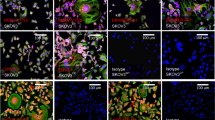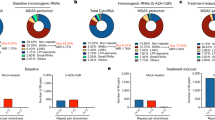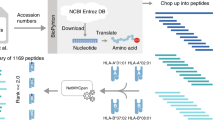Abstract
Transformed cells express high levels of non-telomeric reverse-transcriptase (RT) activity of retrotransposon and endogenous retrovirus origin. We previously reported that RT inhibition, either pharmacological or through transient silencing of RT-encoding LINE-1 (L1) elements by RNA interference (RNAi), reduced proliferation, induced differentiation and reprogrammed gene expression in human tumorigenic cell lines. Moreover, the antiretroviral drug efavirenz antagonized tumor progression in animal models in vivo. To get insight into the role of retroelements in tumorigenesis, we have now produced two cell lines derived from A-375 melanoma, in which the expression of either L1 retrotransposon, or HERV-K endogenous retrovirus, was stably suppressed by RNAi. Compared to the parental A-375 cell line, cells with stably interfered L1 expression show a lower proliferation rate, a differentiated morphology and lower tumorigenicity when inoculated in nude mice. L1 silencing modulates expression of several genes and, unexpectedly, also downregulates HERV-K expression. In HERV-K interfered cells, instead, L1 expression was unaffected, and cell proliferation and differentiation remained unchanged compared to parental A-375 cells.In vivo, however, their tumorigenic potential was found to be reduced after inoculation in nude mice. These results suggest that L1 and HERV-K play specific and distinct roles in cell transformation and tumor progression.
This is a preview of subscription content, access via your institution
Access options
Subscribe to this journal
Receive 50 print issues and online access
$259.00 per year
only $5.18 per issue
Buy this article
- Purchase on Springer Link
- Instant access to full article PDF
Prices may be subject to local taxes which are calculated during checkout





Similar content being viewed by others
Accession codes
References
Batzer MA, Deininger PL . (2002). Alu repeats and human genomic diversity. Nature 3: 370–379.
Beraldi R, Pittoggi C, Sciamanna I, Mattei E, Spadafora C . (2006). Expression of LINE-1 retroposons is essential for murine preimplantation development. Mol Reprod Dev 73: 279–287.
Blaise S, Mangeney M, Heidmann T . (2001). The envelope of Mason–Pfizer monkey virus has immunosuppressive properties. J Gen Virology 82: 1597–1600.
Brouha B, Schustak J, Badge RM, Lutz-Prigge S, Farley AH, Moran JV et al. (2003). Hot L1s account for the bulk of retrotransposition in the human population. Proc Natl Acad Sci USA 100: 5280–5285.
Dent P, Yacoub A, Grant S, Curiel DT, Fisher PB . (2005). MDA-7/IL-24 regulates proliferation, invasion and tumor cell radiosensitivity: a new cancer therapy? J Cell Biochem 95: 712–719.
Ergun S, Buschmann C, Heukeshoven J, Dammann K, Schnieders F, Lauke H et al. (2004). Cell type-specific expression of LINE-1 open reading frames 1 and 2 in fetal and adult human tissues. J Biol Chem 279: 27753–27763.
Farag SS, Caligiuri MA . (2006). Human natural killer cell development and biology. Blood Rev 20: 123–137.
Goldman RD, Gruenbaum Y, Moir RD, Shumaker DK, Spann TP . (2002). Nuclear lamins: building blocks of nuclear architecture. Genes Dev 16: 533–547.
Gruenbaum Y, Goldman RD, Meyuhas R, Mills E, Margalit A, Fridkin A et al. (2003). The nuclear lamina and its functions in the nucleus. Int Rev Cytol 226: 1–62.
Gruenbaum Y, Margalit A, Goldman RD, Shumaker DK, Wilson KL . (2005). The nuclear lamina comes of age. Nat Rev 6: 21–31.
Han JS, Boeke JD . (2005). LINE-1 retrotransposons: modulators of quantity and quality of mammalian gene expression? BioEssays 27: 775–784.
Hasui M, Saikawa Y, Miura M, Takano N, Ueno Y, Yachie A et al. (1989). Effector and precursor phenotypes of lymphokine-activated killer cells in mice with severe combined immunodeficiency (scid) and athymic (nude) mice. Cellular Immun 120: 230–239.
Humer J, Waltenberger A, Grassauer A, Kurz M, Valencak J, Rapberger R . (2006). Identification of a melanoma marker derived from melanoma-associated endogenous retroviruses. Cancer Res 66: 1658–1663.
INTERNATIONAL HUMAN GENOME CONSORTIUM (2001). Initial sequencing and analysis of the human genome. Nature 409: 860–921.
Kazazian HH . (2004). Mobile elements: drivers of genome evolution. Science 303: 1626–1632.
Landriscina M, Fabiano A, Altamura S, Bagala C, Piscazzi A, Cassano A et al. (2005). Reverse transcriptase inhibitors downregulate cell proliferation in vitro and in vivo and restore TSH signaling and iodine uptake in human thyroid anaplastic carcinoma. J Clin Endocrinol Metab 90: 5663–5671.
Mangeney M, Heidmann T . (1998). Tumor cells expressing a retroviral envelope escare immune rejection in vivo. Proc Natl Acad Sci USA 95: 14920–14925.
Mangeney M, Pothlichet J, Renard M, Ducos B, Heidmann T . (2005). Endogenous retrovirus expression is required for murine melanoma tumor growth in vivo. Cancer Res 65: 2588–2591.
Mangeney M, de Parseval N, Thomas G, Heidmann T . (2001). The full-length envelope of an HERV-H human endogenous retrovirus has immunosuppressive properties. J Gen Virol 82: 2515–2518.
Mangiacasale R, Pittoggi C, Sciamanna I, Careddu A, Mattei E, Lorenzini R et al. (2003). Exposure of normal and transformed cells to nevirapine, a Reverse Transcriptase inhibitor, reduces cell growth and promotes differentiation. Oncogene 22: 2750–2761.
Nickerson JA, Krockmalnic G, Wan KM, Penman S . (1997). The nuclear matrix revealed by eluting chromatin from a cross-linked nucleus. Proc Natl Acad Sci USA 94: 4446–4450.
Orgel LE, Crick FH . (1980). Selfish DNA: the ultimate parasite. Nature 284: 604–607.
Pittoggi C, Sciamanna I, Mattei E, Beraldi R, Lobascio AM, Mai A et al. (2003). Role of endogenous reverse transcriptase in murine early embryo development. Mol Reprod Dev 66: 225–236.
Quia F, Zhang ZC, Wu XF, Li YP, Xu Q . (2005). Interaction between integrin alpha(5) and fibronectin is required for metastasis of B16F10 melanoma cells. Biochem Biophys Res Commun 333: 1269–1275.
Ross DA, Laing JH, Sanders R, Wilson GD . (2006). Long term follow-up of c-myc, p53 and proliferation measurements in malignant melanoma. Eur J Surg Oncol 32: 80–84.
Sauter ER, Yeo UC, Von Stemm A, Zhu W, Litwin S, Tichansky DS et al. (2002). Cyclin D1 is a candidate oncogene in cutaneous melanoma. Cancer Res 62: 3200–3206.
Sciamanna I, Landriscina M, Pittoggi C, Quirino M, Mearelli C, Beraldi R et al. (2005). Inhibition of endogenous reverse transcriptase antagonizes human tumor growth. Oncogene 24: 3923–3931.
Shapiro JA, von Sternberg R . (2005). Why repetitive DNA is essential to genome function. Biol Rev 80: 1–24.
Sinibaldi-Vallebona P, Lavia P, Garaci E, Spadafora C . (2006). A role for endogenous reverse transcriptase in tumorigenesis and as a target in differentiating cancer therapy. Genes Chromosomes Cancer 45: 1–10.
Umekita Y, Hiipakka RA, Koknotis JM, Shutsung L . (1996). Human prostate tumor growth in athymic mice: inhibition by androgens and stimulation by finasteride. Proc Natl Acad Sci USA 93: 11802–11807.
Acknowledgements
We are grateful to Dr R Loewer for critical reading of the manuscript. We acknowledge the skillful contribution of A Felici for assistance with animal work. This work was supported by Istituto Superiore di Sanità (grants R002, 501/1, 501/2 to CS) and, in part, by grants SCHU 1014/2-1 and SCHU 1014/2-2 of the Deutsche Forschugsgemeinschaft to GGS.
Author information
Authors and Affiliations
Corresponding author
Rights and permissions
About this article
Cite this article
Oricchio, E., Sciamanna, I., Beraldi, R. et al. Distinct roles for LINE-1 and HERV-K retroelements in cell proliferation, differentiation and tumor progression. Oncogene 26, 4226–4233 (2007). https://doi.org/10.1038/sj.onc.1210214
Received:
Revised:
Accepted:
Published:
Issue Date:
DOI: https://doi.org/10.1038/sj.onc.1210214
Keywords
This article is cited by
-
Differential expression of an endogenous retroviral element [HERV-K(HML-6)] is associated with reduced survival in glioblastoma patients
Scientific Reports (2022)
-
Effect of human endogenous retrovirus-K env gene knockout on proliferation of ovarian cancer cells
Genes & Genomics (2022)
-
High levels of LINE-1 transposable elements expressed in Kaposi’s sarcoma-associated herpesvirus-related primary effusion lymphoma
Oncogene (2021)
-
Technical considerations in detection of HERV-K in amyotrophic lateral sclerosis: selection of controls and the perils of qPCR
Acta Neuropathologica Communications (2019)
-
Transcriptional profiling of HERV-K(HML-2) in amyotrophic lateral sclerosis and potential implications for expression of HML-2 proteins
Molecular Neurodegeneration (2018)



